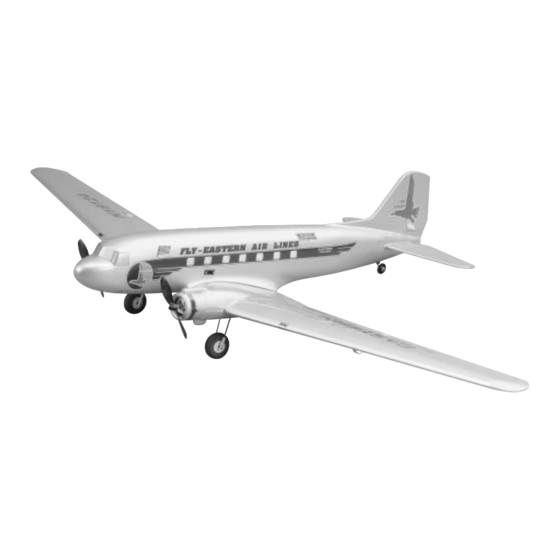GREAT PLANES Douglas DC-3 Manual de instruções - Página 20
Procurar online ou descarregar pdf Manual de instruções para Brinquedo GREAT PLANES Douglas DC-3. GREAT PLANES Douglas DC-3 20 páginas.

Remember to takeoff into the wind. When you're ready, point
the model straight down the runway, hold a bit of up elevator
to keep the tail on the ground, then gradually advance the
throttle. As the model gains speed decrease up elevator
allowing the tail to come off the ground. One of the most
important things to remember with a tail dragger is to always
be ready to apply right rudder to counteract motor torque.
Gain as much speed as your runway and flying site will
practically allow before gently applying up elevator, lifting the
model into the air. At this moment it is likely that you will
need to apply more right rudder to counteract motor torque.
Be smooth on the elevator stick, allowing the model to
establish a gentle climb to a safe altitude before turning into
the traffic pattern.
For reassurance and to keep an eye on other traffic, it is a
good idea to have an assistant on the flight line with you. Tell
him to remind you to throttle back once the plane gets to a
comfortable altitude. While full throttle is usually desirable for
takeoff, most models fly more smoothly at reduced speeds.
Take it easy with the Great Planes DC-3 EP ARF for the first
few flights, gradually getting acquainted with it as you gain
confidence. Adjust the trims to maintain straight and level
flight. After flying around for a while and while still at a safe
altitude with plenty of battery charge, practice slow flight and
execute practice landing approaches by reducing the throttle
to see how the model handles at slower speeds. Add power
to see how she climbs as well. Continue to fly around,
executing various maneuvers and making mental notes (or
having your assistant write them down) of what trim or C.G.
changes may be required to fine tune the model so it flies
the way you like. Mind your battery charge level, but use this
first flight to become familiar with your model before landing.
If you are flying from a grass field you must use some care
when landing. Attempt to land in the smoothest part of the
field. You should also try to land at a slow flying speed, but
not so slowly that the model stalls. This model does not slow
rapidly on final approach, so a low "dragged-in" approach
may be needed. Always land into the wind. Due to the
small wheel size the model may start to nose over. Gradually
applying up elevator after the model has landed will
minimize this.
To initiate a landing approach, lower the throttle while on the
downwind leg. Allow the nose of the model to pitch
downward to gradually bleed off altitude. Continue to lose
altitude, but maintain airspeed by keeping the nose down as
you turn onto the crosswind leg. Make your final turn toward
the runway (into the wind), using coordinated aileron and
rudder control, keeping the nose down to maintain airspeed
Flight
Landing
and control. Level the attitude when the model reaches the
runway threshold, modulating the throttle as necessary to
maintain your glide path and airspeed. If you are going to
overshoot, smoothly advance the throttle (always ready on
the right rudder to counteract torque) and gently climb out to
make another attempt. When you're ready to make your
landing flare and the model is a foot or so off the deck,
smoothly increase up elevator until it gently touches down.
Once the model is on the runway and has lost flying speed,
hold up elevator to place the tail on the ground.
One final note about flying your model. Have a goal or flight
plan in mind for every flight. This can be learning a new
maneuver(s), improving a maneuver(s) you already know, or
learning how the model behaves in certain conditions (such
as on high or low rates). This is not necessarily to improve
your skills (though it is never a bad idea!), but more
importantly so you do not surprise yourself by impulsively
attempting a maneuver and suddenly finding that you've run
out of time, altitude or airspeed. Every maneuver should be
deliberate, not impulsive. For example, if you're going to do
a loop, check your altitude, mind the wind direction
(anticipating rudder corrections that will be required to
maintain heading), remember to throttle back at the top and
make certain you are on the desired rates (high/low rates).
A flight plan greatly reduces the chances of crashing your
model just because of poor planning and impulsive moves.
Remember to think.
Have a ball!
But always stay in control and fly in a safe manner.
GOOD LUCK AND GREAT FLYING!
